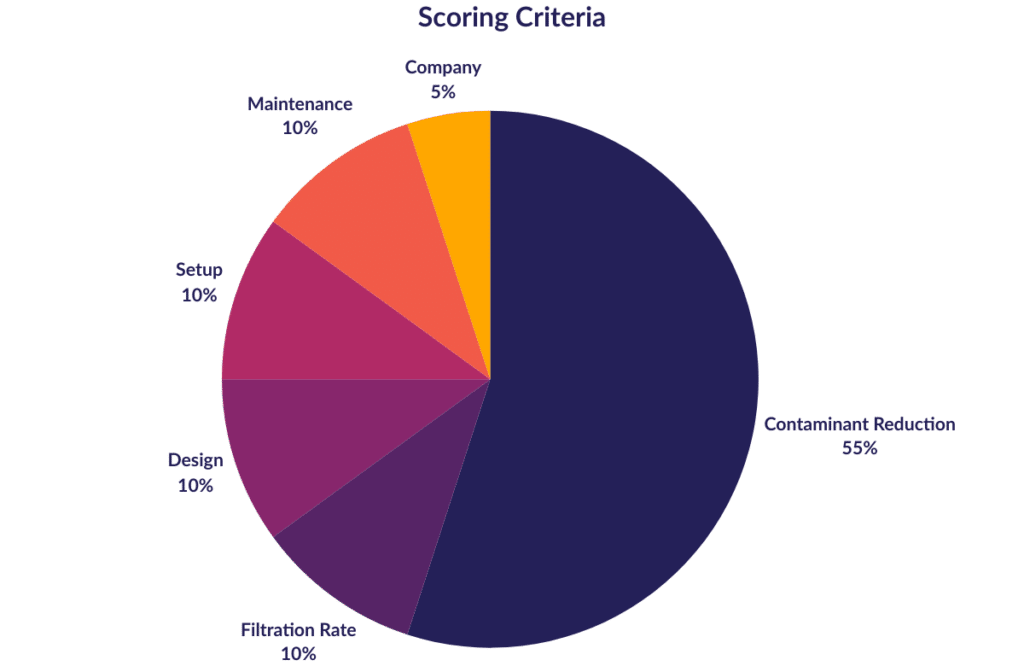The best apartment water filters don’t require a permanent install and performed better than their competitors in our testing. They have the advantage of portability and use different water treatment methods to reduce dozens of common drinking water contaminants.
We produce our product guides using our own data and metrics from a number of different performance categories. Brian Campbell, Water Filter Guru’s founder, personally tested all the systems in this guide. Brian is a WQA Certified Water Specialist and Certified Water Treatment Representative with over 10 years of water treatment industry experience.
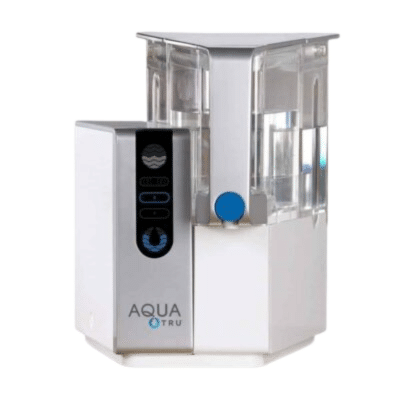
AquaTru
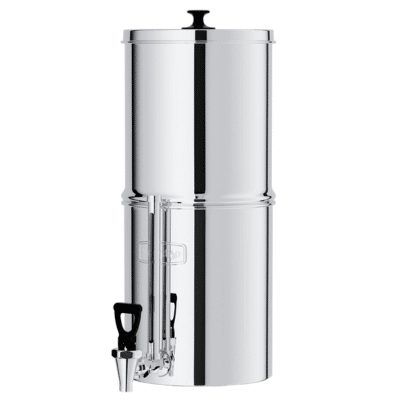
Waterdrop King Tank
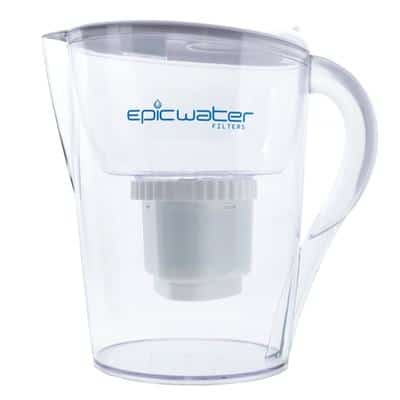
Epic Pure Pitcher
Table of Contents
Our Testing & Selection Process
The 5 Best Apartment Water Filters
| Product |  AquaTru |  Waterdrop King Tank |  Epic Pure | 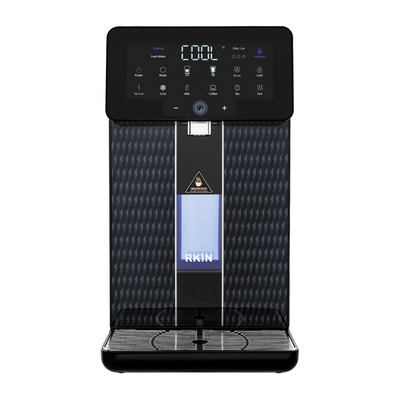 RKIN U1 |  Clearly Filtered |
|---|---|---|---|---|---|
| Score | 9.54 | 9.10 | 8.90 | 8.83 | 8.78 |
| Price | $449.00+ | $229.00+ | $70.00 | $749.95 | $90.00 |
| Certifications | NSF 42, 53, 58, 401, and P473 | NSF/ANSI 372 | Not certified | NSF 58 (in progress) | NSF 42, 53 |
| Filter Capacity | 600-1,200 gallons | 3,000 gallons | 150 gallons | 6, 12, 24 months | 100 gallons |
| Cost per Gallon | $0.11 | $0.06 | $0.17 | $0.08 | $0.55 |
| Warranty | 1 year | 1 year | Lifetime | 1-year warranty & 1 year money-back guarantee | 2 years |
| Read Review | Aquatru review | Waterdrop King Tankeview | Epic Pure review | RKIN U1 review | Clearly Filtered review |
AquaTru

The AquaTru is a countertop reverse osmosis filtration system that got the best contaminant reduction score of all the systems we tested. It’s ideal for apartments because it gets shipped partially assembled and just needs an electricity connection.
Best For
Product Specs
| Price | $449.00+ |
| Contaminants Reduced | 83+ |
| Certifications | NSF 42, 53, 58, 401, and P473 |
| Process | Mechanical + RO + Carbon |
| Filter Capacity | 600-1,200 gallons |
| Annual Cost | ~$100 |
| Warranty | 1 year |
Why It’s Best
The AquaTru is the best overall countertop water filter because it did the best job at reducing contaminants in our water, and it’s also the only system we’ve reviewed that’s certified for the reduction of all the contaminants that the manufacturer claims it can reduce.
The RO unit got the highest contaminant reduction score of all the filters we tested. It’s also the most efficient countertop RO system we’ve used, meaning that it wastes the least amount of water.
AquaTru Performance
We awarded the AquaTru a 9.90 for reducing health-related contaminants in our water. In our testing, it reduced 100% of all the trace contaminants detected – including fluoride, lead, strontium, uranium, molybdenum, and barium – with its incredibly thorough RO purification process.
The system also received a 9.90 score for reducing aesthetic contaminants. It reduced 100% chlorine, including tastes and odors, in our water.
One of the standout features of the AquaTru is that it has obtained IAPMO certifications to NSF Standards 42, 53, 58, 401, and P473 for the reduction of 83 contaminants – better than any other system we’ve tested.
Water waste is an outcome of the RO purification process, and conventional RO systems waste up to 4 gallons of water for every 1 gallon purified. We were pleased to see that the AquaTru has a 4:1 recovery rate, so we only lost 1 gallon of water for every 4 gallons purified.
The AquTru also received a high setup score of 10.00. Most components in the unit were already installed, and we found the filter priming process quick and easy.
Similarly, the system scored a 9.75 for maintenance because of its ease of servicing and its materials safety certification. It also has an NSF 372 certification for lead-free design.
We think the AquaTru is a great apartment water filtration system for folks who have the budget for the best RO system, with an optional remineralization upgrade, that reduces the most contaminants and has extensive certifications.
| Criteria | Results |
|---|---|
| Overall Score | 9.54 |
| Health Related Contaminants | 9.90 |
| Aesthetic Related Contaminants | 9.90 |
| Performance Certification | Certified for 100% of reduction claims |
| Filtration Rate | 0.04 GPM |
| Component Quality | Outstanding |
| Component Certification | Certified |
| Setup | Exceptional |
| Servicing Requirements | Outstanding |
| Costs | $0.11/ gallon |
| Warranty Length | 1 year |
| Shipping | Free shipping |
| Returns | 30 days |
Waterdrop King Tank

The Waterdrop King Tank is a gravity-fed water filter that also performed very well in our contaminant reduction testing. The stainless steel unit doesn’t waste water or use electricity and is a slightly more affordable alternative to the AquaTru.
Best For
Product Specs
| Price | $229.00+ |
| Contaminants Reduced | 10+ |
| Certifications | NSF/ANSI 372 |
| Process | Carbon + Ion Exchange |
| Filter Capacity | 3,000 gallons |
| Annual Cost | ~$60 |
| Warranty | 1 year |
Our Opinion
The Waterdrop King Tank is our top recommended non-RO apartment water filter because it performed very well overall, receiving a high weighted score of 9.10.
The system reduced most of the contaminants in our test water, and while its stainless steel design is a little industrial-looking, we preferred the fact that our filtered water had very minimal contact with plastic compared to many other systems we used.
Plus, the system scored the top score for its 4 GPH filtration rate, performing exceptionally well in this category for a gravity filter.
Waterdrop King Tank Performance
The Waterdrop King Tank received a 9.51 score for contaminant reduction. Our unfiltered water contained lead, aluminum, chlorine, chloroform, manganese, and total THMs, and the system eliminated 100% of these impurities. It also reduced 100% fluoride (with separate fluoride filters), as well as 93% copper, 40% barium, and 28% sulfate.
Unlike AquaTru, the King Tank doesn’t have a performance certification, which negatively impacted its score.
The unit’s design score was almost perfect at 9.40. Many apartment water filters we tested used plastic tanks and components, but the Waterdrop system has been thoughtfully designed to limit water’s contact with plastics as much as possible. Even the spigot is made of stainless steel, although the dispenser component is plastic.
An area that the King Tank struggled in was setup. We awarded it a 6.50 score because we had to prime the filters manually, which was time-consuming and tedious. The system’s 8.50 maintenance score was also influenced by the filter priming issue, despite the fact that the system has one of the lowest costs per gallon of all the countertop filters we’ve tested: just $0.06.
We think the Waterdrop King Tank should appeal to folks who want to minimize their filtered water’s exposure to plastic, or anyone who prefers the additional portability benefits of a gravity filtration system that can be used in any location without electricity.
| Criteria | Results |
|---|---|
| Overall Score | 9.10 |
| Health Related Contaminants | 9.90 |
| Aesthetic Related Contaminants | 9.90 |
| Performance Certification | Not certified for any reduction claims |
| Filtration Rate | 4 GPH |
| Component Quality | Excellent |
| Component Certification | Certified |
| Setup | Failing |
| Servicing Requirements | Weak |
| Costs | $0.06/ gal |
| Warranty Length | 1 year |
| Shipping | Free shipping to lower 48 |
| Returns | 30 days |
Epic Pure Water Filter Pitcher

The Epic Pure Water Filter Pitcher is the best-performing water filter pitcher we’ve tested so far. It’s our top recommended system for smaller budgets and apartments with limited counter space, with a 10-cup capacity and an upfront cost of just $69.
Best For
Product Specs
| Price | $70.00 |
| Contaminants Reduced | 200+ |
| Certifications | Not certified |
| Process | Solid Activated Carbon Block |
| Filter Capacity | 150 gallons |
| Annual Cost | ~$150 |
| Warranty | Lifetime |
What We Thought
The Epic Pure pitcher is the most affordable apartment water filter on this list, and it reduced more contaminants than any similarly-priced system we tested.
It’s also one of the smaller systems we shortlisted for this guide, so it’s great for folks who value their countertop space and don’t want a larger unit dominating their kitchen.
The system has been third-party tested to reduce 200+ contaminants and reduced all impurities to below the lab’s Health Guideline Levels in our testing, making it exceptionally good value for money.
Epic Pure Performance
We awarded the Epic Pure pitcher an overall contaminant reduction score of 9.00, putting it in close third place behind AquaTru and Waterdrop. Our test results showed that it eliminated chlorine, uranium, copper, and phosphorous in our water, as well as reducing 57% molybdenum, 41% barium, 27% fluoride, and 20% nitrate.
Again, we were disappointed to see that the Pure pitcher isn’t performance-certified, which pulled down its score in this category.
While all the apartment filters we tested had easy setup processes, Epic was a standout for us. It obtained a 9.50 score because the assembly and filter prep tasks were minimal – we just washed and assembled the pitcher and reservoir, then inserted the filter. The pitcher was ready to use once we’d filtered and discarded the first two batches of water.
Filtration rate was another category in which the Pure excelled, receiving a 10.00 score from us. It might not match up to the Waterdrop King Tank’s 4 GPH filtration speed, but it came in at 2.23 GPH – still quick for a smaller water pitcher with a single filter.
We think the Epic Pure filter is the ideal space-saving apartment water filter for people who want the most capable budget-friendly system, both upfront and in the long run (it has an ongoing cost of $0.31/ gallon).
| Criteria | Results |
|---|---|
| Overall Score | 8.90 |
| Health Related Contaminants | 9.30 |
| Aesthetic Related Contaminants | 9.90 |
| Performance Certification | Not certified for any reduction claims |
| Filtration Rate | 2.23 GPH |
| Component Quality | Unsatisfactory |
| Component Certification | Not certified |
| Setup | Outstanding |
| Servicing Requirements | Outstanding |
| Costs | $0.31/ gal |
| Warranty Length | Lifetime |
| Shipping | Free shipping for the Clean Water Club only |
| Returns | Lifetime |
RKIN U1

The RKIN U1 is our top recommended premium apartment water filter system with the most comprehensive range of high-tech features. It received the same high contaminant reduction score as the Epic Pure pitcher in our testing, and we loved being able to dispense both hot and cold purified water from the unit at the press of a button.
Best For
Product Specs
| Price | $749.95 |
| Contaminants Reduced | 99% of most contaminants |
| Certifications | NSF 58 (in progress) |
| Process | Mechanical + Carbon + RO + Alkaline + Hydrogen infusion |
| Filter Capacity | 6, 12, 24 months |
| Annual Cost | ~$180 |
| Warranty | 1-year warranty & 1 year money-back guarantee |
Why We Like It
The RKIN U1 is head and shoulders above all the other apartment water filters we tested in terms of its scope of high-tech design features.
It uses reverse osmosis to purify water, then remineralizes it and infuses hydrogen (this is an optional stage that can be turned on or off to your preference), and delivers it at any temperature.
RKIN doesn’t just talk the talk – in our testing, the U1 performed well across the board, and its contaminant reduction abilities were very similar to AquaTru’s, with just one key exception (discussed later).
RKIN U1 Performance
The RKIN U1 secured a 9.00 for contaminant reduction. It was one of the best-performing systems in our water quality testing, reducing 100% lead, uranium, chlorine, fluoride, copper, zinc, and molybdenum. It also greatly reduced nitrate, barium, and sulfate. But strontium increased from 0.108 PPM to 2.42 PPM in our filtered water (we suspect this came from the remineralization filter), and the unit doesn’t have a performance certification, which pulled down its overall score in this category.
The U1’s 1:1 efficiency ratio also wasn’t as impressive as AquaTru’s, and we had to empty the wastewater tank more frequently.
But its performance was otherwise pretty great, especially in the setup and maintenance categories.
We awarded the U1 10.00 and 9.75 scores here because it was super simple to assemble (it’s a plug-and-play system like the AquaTru), and we could simply press a button and leave the unit to prime the filters for us. It also has the lowest projected ongoing cost of all the RO systems we tested, at just $0.0809/ gallon.
The U1’s filtration rate was only a little slower than AquaTru’s, at 0.07 GPM (AquaTru’s measured at 0.08 GPM).
As for design, we loved the U1’s touchscreen control panel, and the different presets meant we could use the system exactly how we wanted. But it received a slightly lower score of 7.50 because it uses a lot of plastic and it isn’t certified for materials safety.

In our opinion, the RKIN U1 is the best apartment water filter for anyone with a bigger budget who wants to invest in a high-tech gadget that purifies water and delivers it exactly to your requirements.
| Criteria | Results |
|---|---|
| Overall Score | 8.83 |
| Health Related Contaminants | 9.30 |
| Aesthetic Related Contaminants | 9.90 |
| Performance Certification | Not certified for any reduction claims |
| Filtration Rate | 0.07 GPM |
| Component Quality | Good |
| Component Certification | Not Certified |
| Setup | Exceptional |
| Servicing Requirements | Outstanding |
| Costs | $0.08/ gal |
| Warranty Length | 1 year |
| Shipping | Free shipping on orders over $175 to lower 48 states |
| Returns | 30 days |
Clearly Filtered Water Pitcher

The Clearly Filtered Water Pitcher is a higher-end water filter pitcher than the Epic Pure, which has been certified by the WQA to reduce chlorine and PFOA/PFOS. It also has a materials safety certification and performed very similarly to Epic when reducing contaminants in our water – but the introduction of cobalt into our water stopped it from taking the top spot.
Best For
Product Specs
| Price | $90.00 |
| Contaminants Reduced | 365+ |
| Certifications | NSF 42, 53 |
| Process | 10 Cups |
| Filter Capacity | 100 gallons |
| Annual Cost | $150 |
| Warranty | 2 years |
Our Verdict
The Clearly Filtered Water Pitcher is the best apartment water filter for folks who value certifications, superior filtration performance, and high-quality design.
Its contaminant reduction abilities were far more advanced than many other pitchers we tested, and the filter’s 100-gallon filter capacity was better than average, too (although Epic’s 150-gallon capacity was still best).
Plus, we sailed through the assembly and maintenance processes – priming the filter took less than 10 minutes and we didn’t have to set reminders for numerous different filter replacements.
Clearly Filtered Performance
The Clearly Filtered Pitcher got a score of 8.24 for contaminant reduction. It gave even the RO systems a run for their money with its 100% fluoride, uranium, chlorine, and copper reduction.
It also reduced 86% barium, 67% strontium, and 53% molybdenum, and we found the filter’s WQA performance certifications reassuring, even if they’re not as extensive as AquaTru’s (it’s only certified to reduce 3 out of the 365+ contaminants on Clearly Filtered’s performance datasheet).
However, the pitcher didn’t do as well at reducing nitrate or sulfate, and the additional 0.0054 PPM of cobalt detected after filtration affected our filtered water quality.
The pitcher’s 2.27 GPH filtration rate was slightly faster than Epic’s (2.23 GPH), and we gave it the top score in this category.
Clearly Filtered also did well in our design testing, with a 9.70 score – the highest we’ve awarded for a water filter pitcher. It’s made from BPA-free Tritan plastic, and we noted that it felt thicker, sturdier, and more durable than most of its competitors. It’s also certified for materials safety and has a WQA certification for lead-free design.
We think the Clearly Filtered pitcher is the best option for folks who prefer the portability and space-saving benefits of a water filter pitcher but only want to consider certified systems. The CF pitcher is around $20 more expensive than the Epic Pure upfront and has a higher ongoing cost ($0.55/ gallon), but you may prefer to spend more on a system with a better design quality and certifications.
| Criteria | Results |
|---|---|
| Overall Score | 8.78 |
| Health Related Contaminants | 8.30 |
| Aesthetic Related Contaminants | 9.90 |
| Performance Certification | Certified for 0.82% of reduction claims |
| Filtration Rate | 2.27 GPH |
| Component Quality | Outstanding |
| Component Certification | Certified |
| Setup | Outstanding |
| Servicing Requirements | Outstanding |
| Costs | $0.55/ gallon |
| Warranty Length | 2 years |
| Shipping | Free shipping all orders |
| Returns | 30 days |

